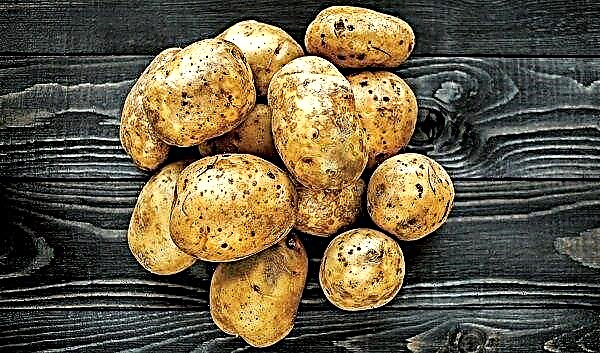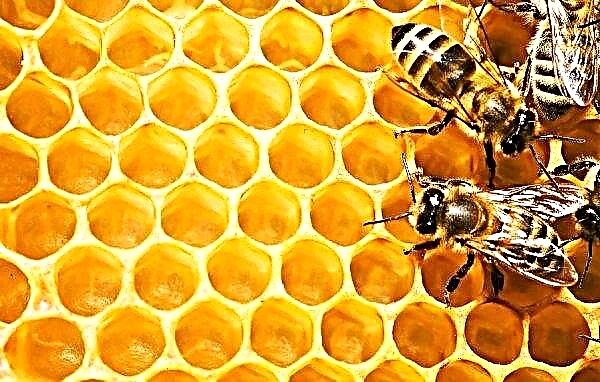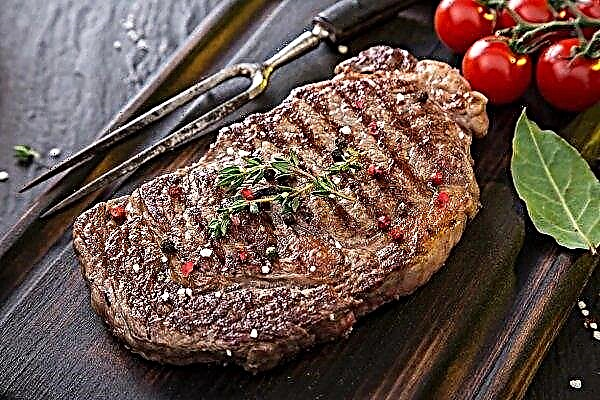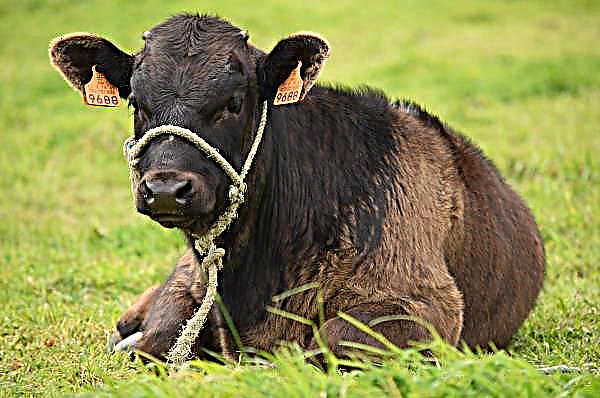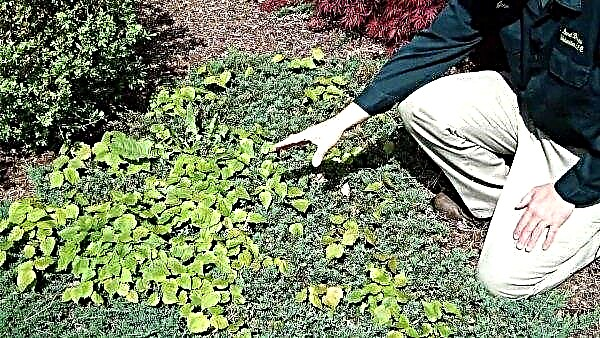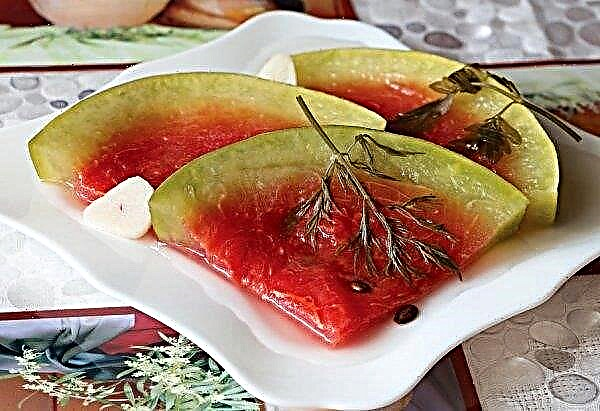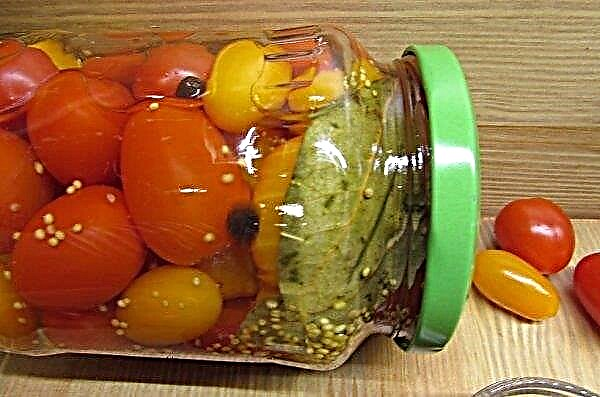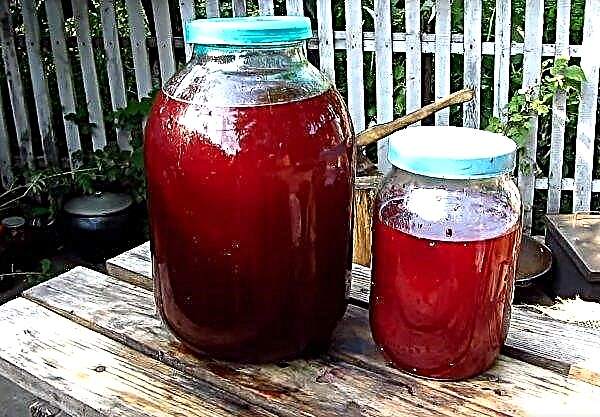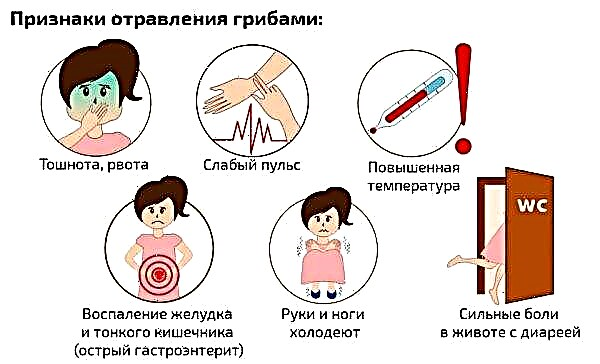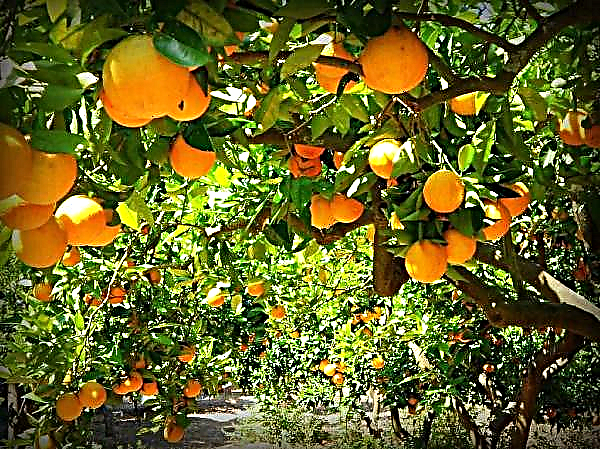Gardeners love pumpkin for unpretentiousness, versatility and taste. Especially popular is the large-fruited variety "sweetie", which contains a lot of sugar in the pulp and is therefore actively used in cooking. Undemanding pumpkin to care allows you to quickly and effortlessly grow vegetables in the garden. In the article below, we suggest that you familiarize yourself with the variety, its advantages and disadvantages, agricultural farming techniques, as well as useful recommendations for care.
Description and characteristics of the variety
Relating to mid-season pumpkin varieties, “sweetie” and its hybrid “sweetie F1” perfectly tolerate cold and are considered the most productive - with proper care, from each wattle fence you can get up to 6–9 fruits. "Sweetie" is useful not only for people, but also for animals - pumpkin is suitable as feed for livestock, so farmers seek to plant the maximum number of plantations with it. Vegetable Feature:
| Appearance | The plant is low, producing whips, the maximum length of which does not exceed one and a half meters. On each lash, 6 to 9 fruits ripen. |
| Fruit size | From 1.5 to 3 kg. |
| Fruit shape | Round. |
| Leaf shape | Pentagonal. |
| Colour | Bright orange segmented. |
| Pulp | Thick, sweet, the composition includes antioxidants such as ascorbic acid and carotene. The seed nest is small. |
| Seeds | Large, coated. |
| Peel | Thick, smooth, orange. |
| Peduncle | Ribbed, pentahedral, extended to the base. |
| Roots | They have the ability to interweave, well developed. |
Advantages and disadvantages
- "Sweetie" in all respects wins the rest of the varieties, and here's why:
- the main advantage is resistance to diseases and pests, as well as adverse climatic conditions;
- high content of vitamins;
- unpretentiousness in care and cultivation;
- excellent taste and marketability;
- high productivity;
- universality in use;
- good transportability;
- long shelf life, during which the pumpkin becomes sweeter and softer.
The disadvantages of vegetable growers include only the need for a large area for plant growth.
Photo gallery
Planting and growing
Pumpkin of this variety is not much different in planting and agricultural cultivation from others. In general, it is unpretentious, and the process of caring for the plant is simple. To get a good harvest, which can be awarded to you "sweetie", you only need to adhere to the rules and take into account some features. More on this.
Soil and crop rotation requirements
Pumpkin is a heat-loving vegetable, therefore, in the southern regions, the plant is grown from seeds, and in the northern regions - seedlings. When planting "candy" in the open ground, the requirements of the variety should be taken into account:
- Observe crop rotation standards, the main condition of which is to plant pumpkin plants in the previous place no earlier than 4 years later.
- Plant "candy" on medium and light loamy soils, well spiced with organic matter.
- The minimum distance between plants should be at least 95 cm.
- The variety must be grown in soil of a strictly defined composition, if it is not possible to provide one, dig up the raised beds, thereby eliminating the weeds.
- Before planting, you need to dig up the soil and add fertilizer - this can be manure or compost.
Important! Given the fact that fertilizer consumption per 1 square. m is 8 kg, 60 g of superphosphate and 3 cups of ash are added to depleted soil.
Optimal conditions
For "sweetie" the acceptable soil temperature is +10 ... + 13 ° C, when it comes to planting vegetables with seeds. For growing pumpkins, it is better to choose the side of the site that is illuminated by the sun, because with a lack of sunlight, the risk of diseases and pests will increase. It is recommended to plant as far away as possible from heavily growing crops with sprawling bushes. Humidity should not exceed 60%. Together, all of these factors will lead to the formation of persistent and generously bearing plants.
It is recommended to plant as far away as possible from heavily growing crops with sprawling bushes. Humidity should not exceed 60%. Together, all of these factors will lead to the formation of persistent and generously bearing plants.
Features of sowing seeds
Seeds for seedlings are usually planted in late April - early May. Mandatory protective measures for sowing seeds include their preliminary verification for germination and processing. The first is necessary in order to plant high-quality seed, which by the end of the procedure should have time to hatch. To do this, the seeds are left wrapped in a damp cloth for 24 hours.
After selection of the sprouted seeds, they should be decontaminated: soaking for a day in a weak solution of manganese or manure diluted with water. As an additional procedure, it is possible to harden: soak the seeds in warm water and place in the refrigerator for 2-3 days, while not allowing germination.
As an additional procedure, it is possible to harden: soak the seeds in warm water and place in the refrigerator for 2-3 days, while not allowing germination.
While the seeds go through the disinfection procedure, it's time to take care of the seedling tank and soil. A suitable container would be cardboard boxes, plastic bottles or disposable glasses. If you chose a bottle as a container, then you need to cut off not only the top, but also the bottom, since the sensitive roots of a pumpkin can easily be damaged during transplanting. The container itself should not exceed 9 cm in height, so that later it can be easily moved and the soil is poured into the container.
Now you can start planting seeds for seedlings. It is produced as follows:
- In a pre-dug and moistened hole, the depth of which depends on the climatic conditions of the region - if the next frost is not expected, then it is permissible to plant the seeds to a depth of 5 cm. However, if the temperature is stable minus, the tab increases to 10 cm. 2-3 seeds must be placed.
- The next stage is to fill them with water, lightly sprinkle with earth on top.
- Then the seedlings are cleaned in a warm and well-lit place.
- After the seedlings sprout a little, strong sprouts must be left, and weaker ones must be removed to avoid root entanglement.

Seedling Care
Caring for the seedlings of pumpkin varieties “sweet” is simple and does not differ from the procedures for caring for other crops - it is enough to carry out regular watering and observe the temperature regime. General recommendations for the care of seedlings are as follows:
- watering the seedlings is not necessary abundantly, but often, the water temperature is at least +20 ° C;
- like overdrying, it is better not to allow excessive soil moisture, otherwise the seedlings will be elongated;
- the first few days it is important to keep the seedlings in the correct temperature conditions: during the day the seedlings should be at a temperature of +20 ... + 23 ° С, and at night - +14 ... + 17 ° С. After another week, the temperature must be lowered so that the seedlings do not stretch - during the day it should be +15 ... + 17 ° С, and at night - +13 ... + 14 ° С;
- at the same time, it is advisable to fertilize with fertilizers - a mullein solution is suitable, but if it is absent, you can do with a fertilizer called Nitrofoska.
 Subject to the above conditions, at the time of transplanting seedlings to a permanent place, seedlings must have strong stems and at least 2 well-developed leaves of saturated green color.
Subject to the above conditions, at the time of transplanting seedlings to a permanent place, seedlings must have strong stems and at least 2 well-developed leaves of saturated green color.Did you know? In the old days it was customary to consider pumpkin a cure for snakebites, and the vegetable was also used to combat freckles. Now pumpkin seeds help get rid of worms and perfectly relieve pain during burns.
Planting seedlings in the ground
Planting grown and stronger seedlings in open ground is carried out in late May - early June, when the temperature is not less than +18 ° С. Given that the pumpkin needs constant heat and light, you should choose a site on the south side, protected from the wind.
The technology of planting seedlings is as follows:
- Since the pumpkin has a well-developed root system, the plants should be at least a meter apart from each other.
- Pre-dug holes in diameter should be at least 60 cm and have an acceptable depth for root development.
- If desired, fertilizers can be added, then the hole should be plentifully filled with water and the seedling should be carefully transplanted, filling the voids with earth.
- Immediately after this, the hole must be mulched with peat or ordinary earth to avoid premature evaporation of moisture and to allow the sprout to adapt to new conditions.
- It will not be out of place for the first week to cover the seedlings with garden film, which will accelerate plant growth and consolidate the adaptation process.

Care Features
Caring for seedlings planted at a permanent place includes watering and top dressing, loosening the soil, weeding the beds, as well as protecting plants from diseases and pests that can destroy the crop. However, all these activities must be carried out before the foliage on the pumpkin closes. Similar procedures begin 10 days after transplanting seedlings in open ground. Let's consider each of them in more detail.
Watering and feeding
Pumpkin does not need a lot of moisture. Watering plants can be infrequent, but plentiful, since most of the roots are located at a depth, and moisture must be got there. If the pumpkin grows under a film that you do not intend to shoot during its entire growing season, watering procedures are reduced to a minimum, excluding intensive fruit growth.
Top dressing should be carried out regularly to maintain the balance of minerals in the soil and improve the quality and quantity of the crop. For a good result, it is better to alternate mineral and organic dressings.  Organic manure can be manure diluted with water (1:20), chicken droppings (1:10) or diluted mullein (1: 7). Each plant must be given a liter of such fertilizer until the fruit is strong. You can also use the store fertilizer “AVVA”, which is applied by teaspoon to each well right before planting, thus providing the pumpkin with a complete feeding complex for the whole season.
Organic manure can be manure diluted with water (1:20), chicken droppings (1:10) or diluted mullein (1: 7). Each plant must be given a liter of such fertilizer until the fruit is strong. You can also use the store fertilizer “AVVA”, which is applied by teaspoon to each well right before planting, thus providing the pumpkin with a complete feeding complex for the whole season.
Do not neglect the mineral dressings necessary for plants to gain mass at the initial stage of growth.
Important! After stopping the growth and development of the fruit, the watering and top dressing procedures must be stopped, otherwise the pumpkins will not be stored due to an excess of moisture in the pulp.
Loosening the soil and weeding the beds
A prerequisite for obtaining a good harvest is loosening the soil, which protects against the formation of earth crust. This procedure is carried out until the rows are closed approximately in mid-June. For this purpose use choppers, hoes, pitchforks, plane cutters. A suitable time for loosening will be recent rain or watering, while the soil has not yet dried. It is recommended to carry out loosening not once, but several times, in order to prevent a slowdown in the growth and development of plants, as well as to ensure constant access of roots to oxygen. An equally important agricultural technique is weeding, which eliminates vegetables from weeds. This event should be carried out regularly and responsibly - hands should be protected with gloves during this process, and weeds should be placed in a specially prepared container, and not on a bed, otherwise they will sprout again after rain.
An equally important agricultural technique is weeding, which eliminates vegetables from weeds. This event should be carried out regularly and responsibly - hands should be protected with gloves during this process, and weeds should be placed in a specially prepared container, and not on a bed, otherwise they will sprout again after rain.
Unlike loosening, weeding the beds is done in sunny and dry weather, because the sun's rays dry the roots of the weeds and inhibit their growth. At the initial stage, it is desirable to carry out this procedure manually, without using tools, in order to reduce the risk of deformation of immature plants.
Bush formation
 The formation of a pumpkin bush is as important a procedure as watering or loosening, since it directly affects the amount of the crop, and hence its marketability and taste. This event consists of two stages - pinching and pinching. It is necessary to remove excess shoots from the plant in order to allow the main to develop.
The formation of a pumpkin bush is as important a procedure as watering or loosening, since it directly affects the amount of the crop, and hence its marketability and taste. This event consists of two stages - pinching and pinching. It is necessary to remove excess shoots from the plant in order to allow the main to develop.
Pinch the “sweetie” after 2–3 fetuses are formed on the main lash, 6 sheets must be counted from the last and the growth bud must be carefully pinched off. Thus, the plant directs all its forces to the development and early ripening of fruits, which in the future will positively affect the total quantity and quality of the crop.
Pumpkin is a long-climbing plant, therefore, for the correct formation of the bush, the pumpkin lashes must be decomposed so that they do not get confused with each other and do not interfere with sunlight. It is also important to spread the leaves.
Video: Pumpkin Formation
Diseases and Pests
In the process of cultivating any crop, it is important to take care of eliminating factors that can lead to complete or partial loss of yield, that is, diseases and plant pests. "Sweetie", although resistant to disease, is still not immune from powdery mildew, rot, bacteriosis. Therefore, it is necessary to carry out preventive measures:
- Observe crop rotation requirements.
- Get rid of plant debris in time.
- Plow and irrigate the soil regularly.
- Immunize and spray plants with drugs aimed at preventing ailments.
Did you know? In total, there are about 60 varieties of pumpkins, in which in addition to the orange color of the peel, green, white and blue are found.
Harvest dates and storage
The fruits of the variety do not have specific harvesting dates, since their ripening depends on climatic conditions and soil conditions. Usually the crop is harvested before the onset of frost, exclusively in dry weather. During the cut, pumpkins from the whip leave the stalk (approximately 5–7 cm), and the fruits are not wet and protected from damage. Fruits for storage should be firm, strong, without dents. The selected pumpkins are stacked in one layer on a soft plane so that they do not touch each other, and stored at a temperature not exceeding + 10 ° C and humidity not less than 80%. For this purpose, you can use a refrigerator.
Fruits for storage should be firm, strong, without dents. The selected pumpkins are stacked in one layer on a soft plane so that they do not touch each other, and stored at a temperature not exceeding + 10 ° C and humidity not less than 80%. For this purpose, you can use a refrigerator.
The pumpkin with the tempting name “sweetie”, thanks to outwardly attractive fruits, will decorate your garden and add variety to the menu, since delicious pulp gives freedom of imagination and various culinary experiments. Without losing its popularity, the variety successfully pays off and is recognized by vegetable growers, delighting with a plentiful and tasty harvest from season to season.

